Kuwait is home to a wide variety of bird species, from migratory waders to desert-adapted birds. Many of these species are found nowhere else in the world and offer a unique insight into the ecology of this region.
This article will provide an overview of the different types of birds found in Kuwait, their habitats, and the threats they face. It will also discuss the importance of protecting these species for the future.
1. MacQueen’s Bustard
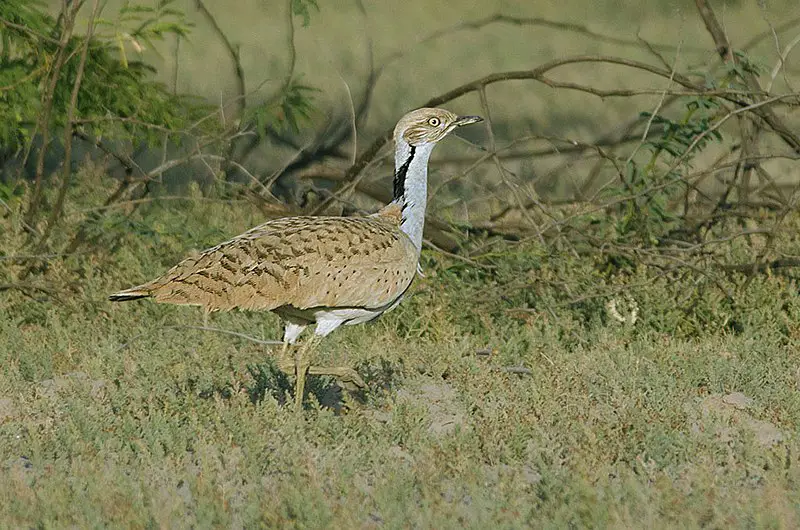
MacQueen’s bustard is a large bird in the bustard family, native to desert and steppe regions of Asia. This species was once seen as far west as Great Britain but has since declined by 20-50% due to hunting and changes in land use.
Its loss has caused concern among conservationists, with some even considering it endangered. It typically lives on dry plains or semi-desert areas where there are low shrubs for cover from predators such as foxes or eagles.
The MacQueen’s Bustard feeds mainly on insects like grasshoppers, spiders and beetles which they find amongst vegetation like shortgrass prairies or agricultural fields.
They also eat small mammals when available during winter months; however this does not make up their primary diet year round.
To protect them from further decline we must work together to reduce hunting pressures and conserve habitat so that these birds can continue living wild into future generations.Scientific classification:
| Kingdom | Animalia |
| Phylum | Chordata |
| Class | Aves |
| Order | Otidiformes |
| Family | Otididae |
| Genus | Chlamydotis |
| Species | C. macqueenii |
2. Long-Tailed Duck
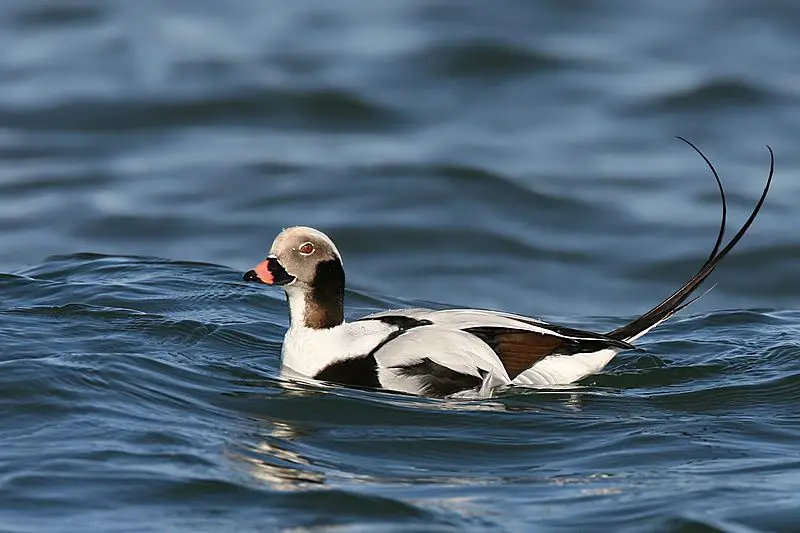
The Long-tailed duck, also known as the Oldsquaw, is a medium-sized sea duck found in the tundra and taiga regions of Arctic during breeding season.
It winters along northern coastlines of the Atlantic and Pacific Oceans.
This bird was formally described by Swedish naturalist Carl Linnaeus in 1758. The body length of this species varies from 44 to 57 cm with wingspan extending up to 80 cm long having unique tail feathers that are nearly twice their body length.
They have an elongated head which can be easily spotted when they swim on water surface or fly high above it.
Their diet consists mainly fishes, mollusks and aquatic insects which they hunt while swimming beneath water’s surface using their strong feet for propulsion into deeper waters unlike other ducks who feed on land surfaces near lakes or ponds..Scientific classification:
| Kingdom | Animalia |
| Phylum | Chordata |
| Class | Aves |
| Order | Anseriformes |
| Family | Anatidae |
| Genus | Clangula Leach, 1819 |
| Species | C. hyemalis |
Also Featured In: Birds of Orkney, Most Common Birds of Netherlands Island
3. Marbled Duck
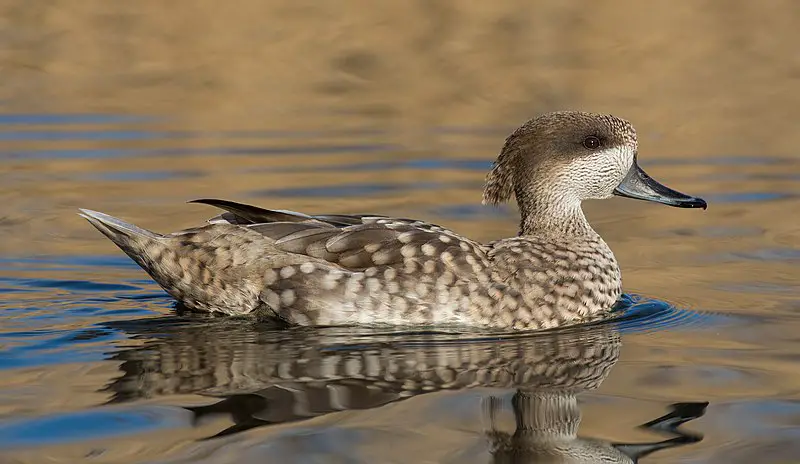
The Marbled duck is a medium-sized species of waterfowl native to southern Europe, northern Africa, and western and central Asia.
It gets its name from the marbling pattern on its feathers which give it an eye-catching mottled appearance.
The scientific name comes from Greek and Latin words meaning “marble”, “duck”, “narrow or small” and ‘billed’ respectively.
In the past these ducks bred in large numbers throughout the Mediterranean region but their population has declined due to human activities such as hunting for sport as well as habitat destruction.
Conservation efforts are underway in order to protect this beautiful bird so that future generations can still enjoy seeing them around.Scientific classification:
| Kingdom | Animalia |
| Phylum | Chordata |
| Class | Aves |
| Order | Anseriformes |
| Family | Anatidae |
| Genus | Marmaronetta Reichenbach, 1853 |
| Species | M. angustirostris |
4. Afghan Babbler
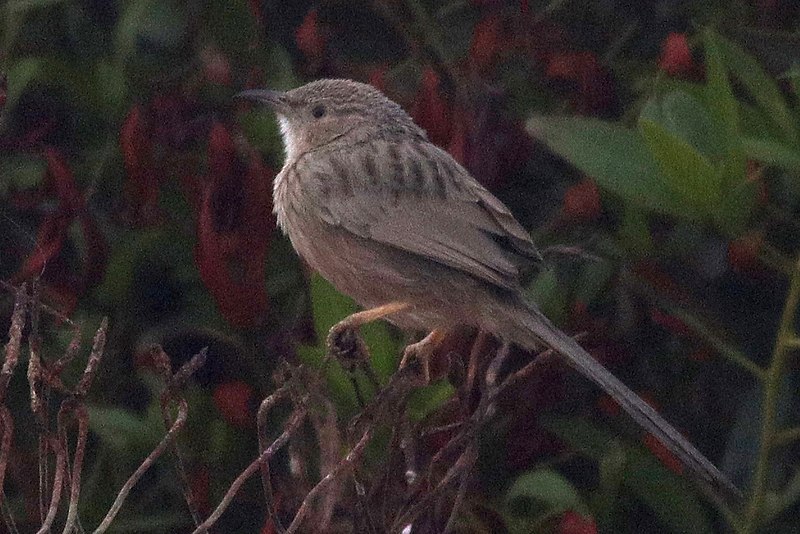
The Afghan babbler is a species of bird found in southeastern Iraq and southwestern Pakistan.
It was formerly classified as a subspecies of the common babbler but can be distinguished by its heavier bill and dark streaks on the breast and sides.
Its vocalizations also differ from those of its counterpart, making it easy to identify.
These birds are often seen foraging together in groups or pairs, searching for food such as insects, fruits, seeds and small vertebrates like lizards or frogs.
They sometimes flock with other species such as mynas or barbets when there is enough food available to share amongst them all.
With their unique features combined with their social behavior they make an interesting addition to any avian enthusiast’s list.Scientific classification:
| Kingdom | Animalia |
| Phylum | Chordata |
| Class | Aves |
| Order | Passeriformes |
| Family | Leiothrichidae |
| Genus | Argya |
| Species | A. huttoni |
5. Greater White-Fronted Goose
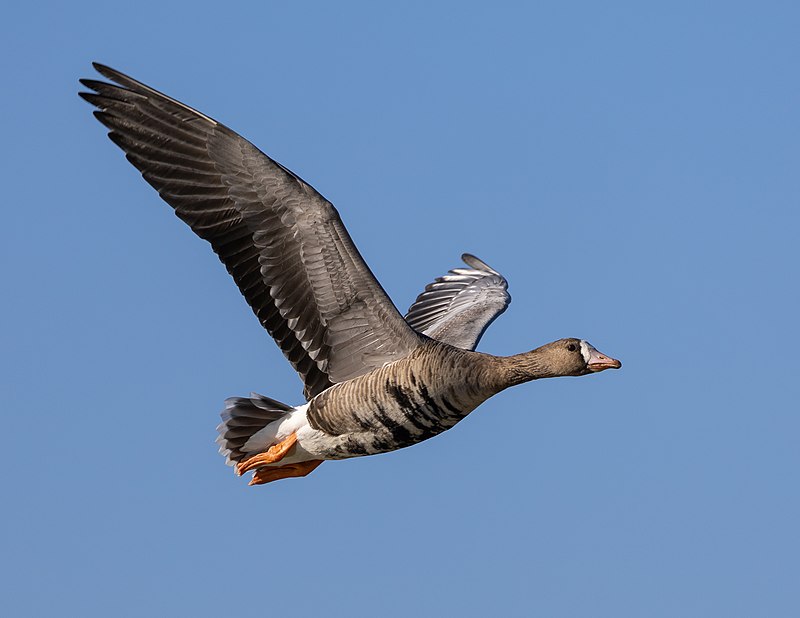
The Greater White-fronted Goose is a species of waterfowl native to the subarctic regions of North America and Eurasia.
Its distinguishing feature is the large white patch that runs from its bill down to its throat, earning it its Latin name “albifrons” which translates as ‘white forehead’.
This bird can grow up to 28 inches in length with a wingspan of 50 inches and weigh 2lbs. It feeds mainly on plant material such as grasses, sedges, grains and berries.
The Greater White-fronted Goose also likes areas near rivers or lakes where they forage for food during their annual spring migration across continents ranging from Alaska all the way into Russia.Scientific classification:
| Kingdom | Animalia |
| Phylum | Chordata |
| Class | Aves |
| Order | Anseriformes |
| Family | Anatidae |
| Genus | Anser |
| Species | A. albifrons |
6. Red-Breasted Merganser
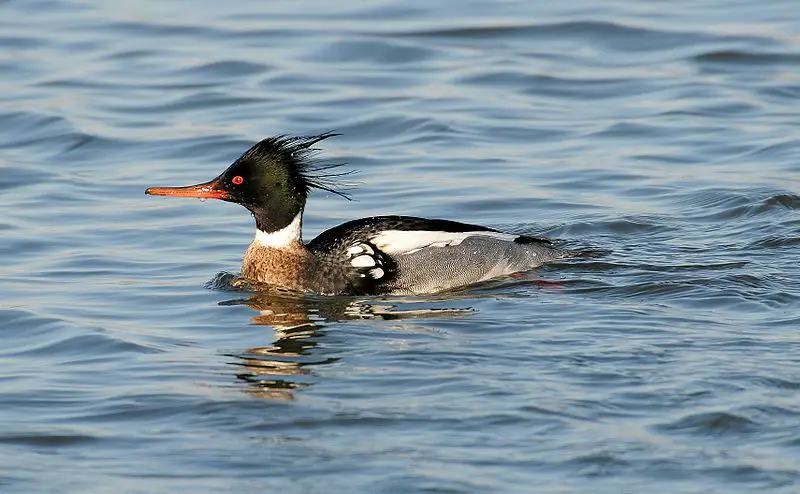
The Red-breasted merganser is a diving duck, part of the sawbills family. It was first described in 1758 by Carl Linnaeus with its Latin name “Mergus Serrator” meaning sawyer or cutter.
With their red breast feathers and black heads, these birds are easy to spot when they’re near water bodies such as lakes and rivers hunting for fish.
They also feed on crustaceans and mollusks that they catch underwater.
During breeding season, the males develop white patches around their eyes making them even more distinct from other species of ducks.
The Red-breasted Mergansers’ population numbers have been declining over recent years due to habitat loss caused by human activities like construction projects close to wetlands where these birds live but conservation efforts can help protect this majestic bird’s future generations.Scientific classification:
| Kingdom | Animalia |
| Phylum | Chordata |
| Class | Aves |
| Order | Anseriformes |
| Family | Anatidae |
| Genus | Mergus |
| Species | M. serrator |
Also Featured In: Flight Birds You Should Know, Shetland Islands Birds You Should Know
7. Red-Crested Pochard
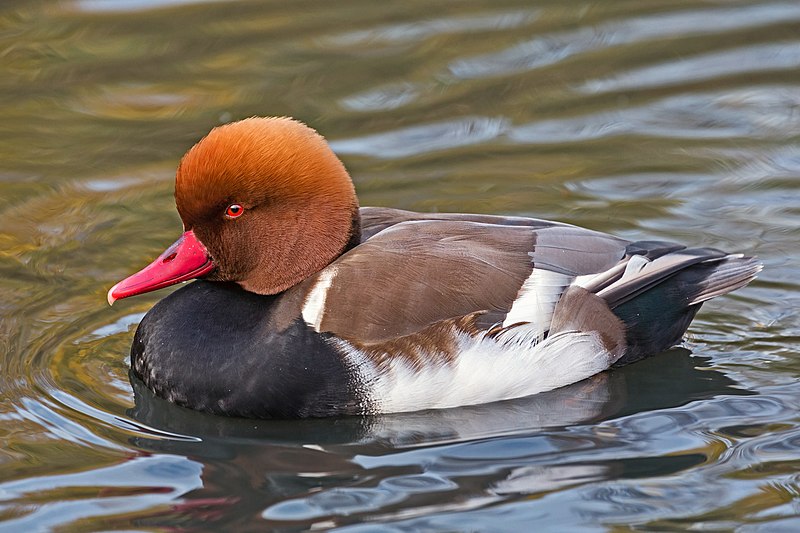
The Red-crested Pochard is a beautiful diving duck, easily recognizable by its golden-red head and neck.
Found in southern Europe and Central Asia to Mongolia, this large bird also spends winter months along the Indian subcontinent and Africa.
They inhabit lowland marshes and lakes where they feed on aquatic plants as well as small fish or insects that they dive for.
In flight, their wings make a loud whistling sound due to their size which gives away their presence even when far off.
These birds are social creatures often found swimming in flocks of several dozens making them an impressive sight indeed.Scientific classification:
| Kingdom | Animalia |
| Phylum | Chordata |
| Class | Aves |
| Order | Anseriformes |
| Family | Anatidae |
| Genus | Netta |
| Species | N. rufina |
8. Common Pochard
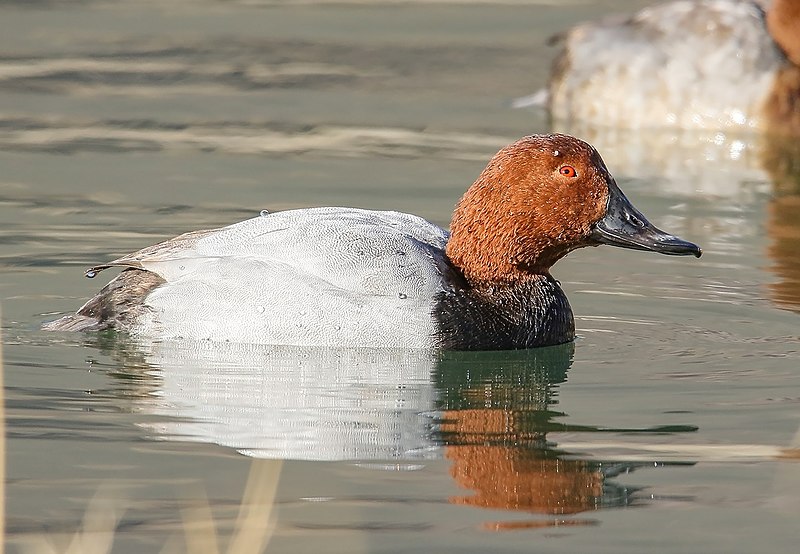
The Common Pochard is a medium-sized diving duck found across Eurasia and North Africa. It has distinctive features such as a long, dark bill with a grey band, red head and neck, black breast, red eyes and grey back.
The female has similar characteristics but her head is more brown/grey in colour than the male’s striking red hue.
They are often seen swimming together in large flocks near freshwater bodies or on lakes to feed on aquatic plants like seeds of waterlilies etc., which makes them an important part of the ecosystem by helping disperse plant species.
Their loud call can be heard over vast distances making them easy to spot even when they’re far away.Scientific classification:
| Kingdom | Animalia |
| Phylum | Chordata |
| Class | Aves |
| Order | Anseriformes |
| Family | Anatidae |
| Genus | Aythya |
| Species | A. ferina |
9. Garganey
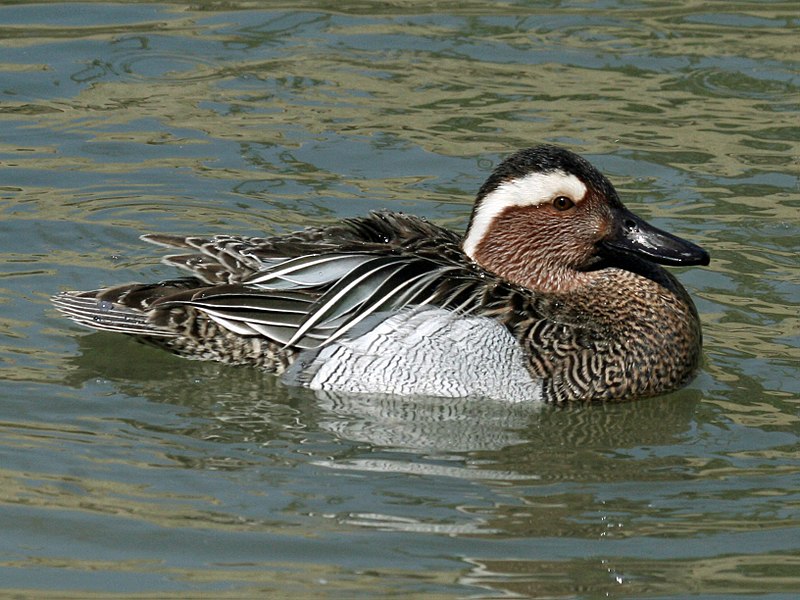
The Garganey is a small dabbling duck that breeds in much of Europe and across the Palearctic. During winter, it migrates to southern Africa, India (Santragachi), Bangladesh (in Sylhet district) and Australasia where large flocks can be seen.
It has an unmistakable appearance with its brownish head and grey body covered by white patches on both sides along with blue speculum feathers at the back of wings.
Its diet mostly consists of aquatic vegetation such as grasses, sedges or pondweeds which are usually collected from shallow waters like marshes or ponds while swimming.
The species is vulnerable due to loss of wetland habitats caused by drainage for agriculture purposes or urban development making them increasingly rarer throughout their range.Scientific classification:
| Kingdom | Animalia |
| Phylum | Chordata |
| Class | Aves |
| Order | Anseriformes |
| Family | Anatidae |
| Genus | Spatula |
| Species | S. querquedula |
Also Featured In: Birds Found in Hungary, Belarus Birds You Should Know
10. Tufted Duck
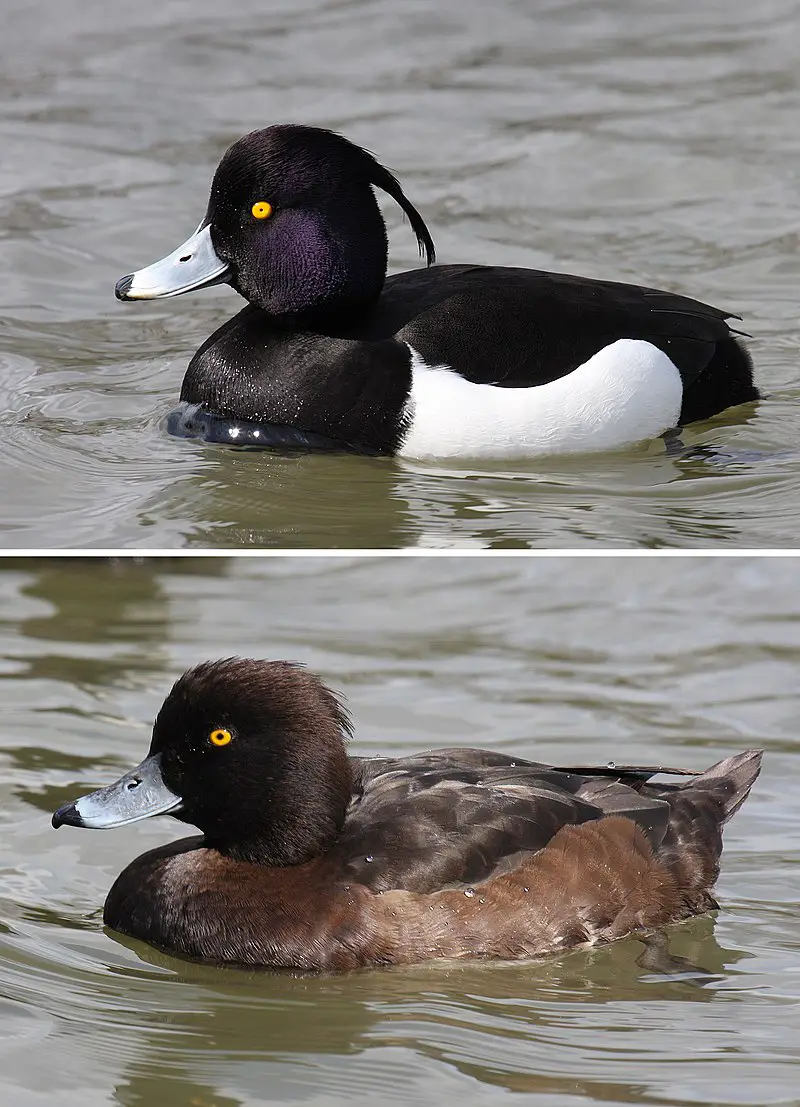
The Tufted Duck is a small diving duck which can be found in northern Eurasia, with an estimated population of nearly one million. It gets its scientific name from Ancient Greek and Latin words meaning “sooty throat”.
The adult male has black plumage except for white flanks and a blue-grey bill. Its head is also adorned by the distinctive tufts that give it its common name.
Females are brownish grey on their upper parts and have paler underparts than males as well as having orange bills instead of blue-grey ones like their male counterparts.
This species feed mainly on aquatic plants but will occasionally eat molluscs, crustaceans, insects or worms when they’re available too.
They are generally quite shy birds so keep your distance if you spot them while out in nature to avoid disturbing them unnecessarilyScientific classification:
| Kingdom | Animalia |
| Phylum | Chordata |
| Class | Aves |
| Order | Anseriformes |
| Family | Anatidae |
| Genus | Aythya |
| Species | A. fuligula |
Also Featured In: East African Birds, Common Birds of Maharashtra
11. Common Shelduck
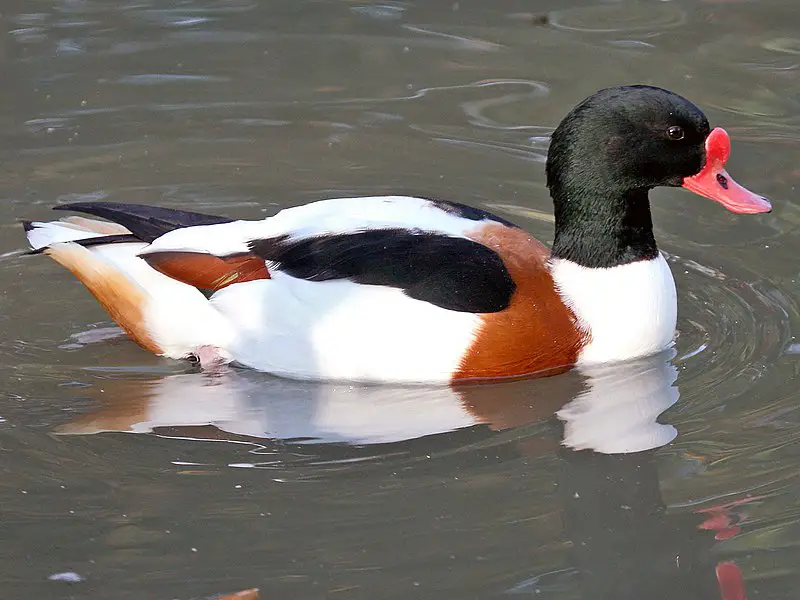
The Common Shelduck is a species of waterfowl belonging to the shelduck genus, Tadorna. It can be found in temperate and subtropical regions across the Euro-Siberian region of the Palearctic.
During winter months, it also ventures into Maghreb. Fossil bones discovered from Dorkovo (Bulgaria) are believed to belong this bird’s species as well – Balcanas pliocaenica.
The Common Shelduck has a large body with short legs and wings that enable it for powerful flight capabilities during migratory seasons along with long bills perfect for digging up food sources such as mollusks or aquatic vegetation habits these birds have adapted over time in wetland habitats they inhabit making them an essential part of many ecosystems around Europe and Asia.Scientific classification:
| Kingdom | Animalia |
| Phylum | Chordata |
| Class | Aves |
| Order | Anseriformes |
| Family | Anatidae |
| Genus | Tadorna |
| Species | T. tadorna |
Also Featured In: Native Birds of Kazakhstan,
12. Ruddy Shelduck
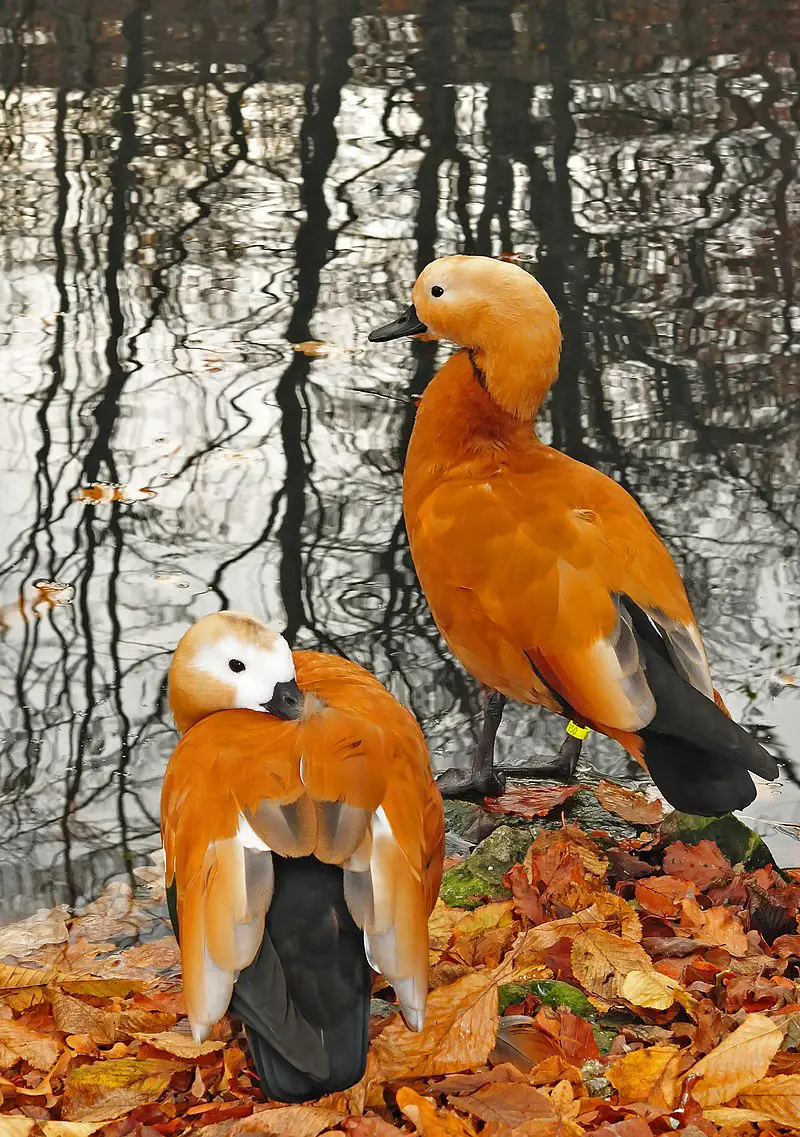
The Ruddy Shelduck is a unique and vibrant waterfowl, easily recognizable due to its orange-brown body plumage with a paler head.
It measures between 58 cm – 70 cm in length and its wingspan ranges from 110 cm – 135cm.
Its tail feathers along with the flight feathers are black in colour, standing out against the white wing coverts.
This bird can be found throughout Europe, Asia and Africa as it migrates regularly during certain times of year.
Its diet consists mainly of plant material such as roots & tubers; however they do occasionally eat small insects or molluscs for extra nutrition when available.
The Ruddy Shelduck makes an interesting addition to any aviary.Scientific classification:
| Kingdom | Animalia |
| Phylum | Chordata |
| Class | Aves |
| Order | Anseriformes |
| Family | Anatidae |
| Genus | Tadorna |
| Species | T. ferruginea |
Also Featured In: Moscow Birds You Need to See, Birds of Jim Corbett National Park
13. Sykes’s Warbler
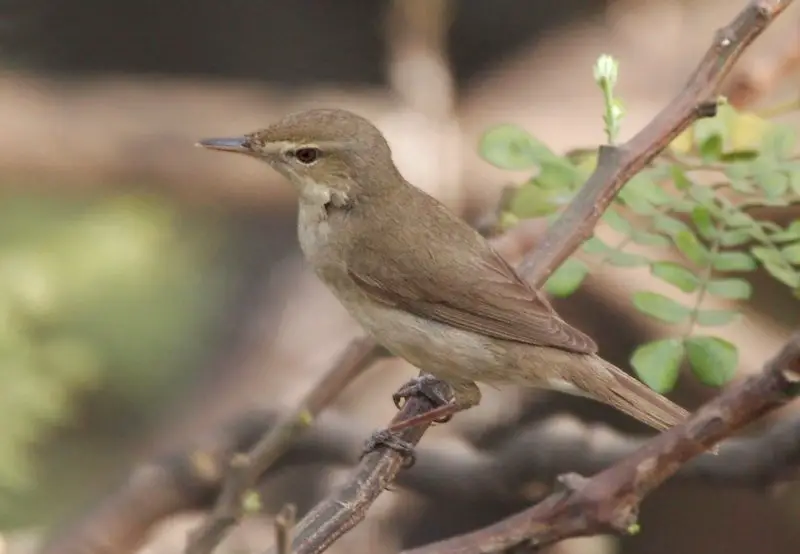
Sykes’s warbler is an Old World warbler belonging to the tree warbler family. It was once considered a subspecies of booted warbler, however it has now been classified as its own species.
Its breeding range spreads from northeast Arabia all the way to Turkestan, west China and Afghanistan.
During winter season many populations of Sykes’s Warblers migrate southwards towards Indian Subcontinent and Sri Lanka for warmer climates.
This bird is small in size with grey-brown upperparts and whitish underparts that are streaked by black spots on chest area along with two white wingbars which makes them easily identifiable among other birds.
They feed mainly on insects found near trees or bushes during summer months while consuming fruits when no food sources are available in winters making them omnivorous speciesScientific classification:
| Kingdom | Animalia |
| Phylum | Chordata |
| Class | Aves |
| Order | Passeriformes |
| Family | Acrocephalidae |
| Genus | Iduna |
| Species | I. rama |
14. Pin-Tailed Sandgrouse
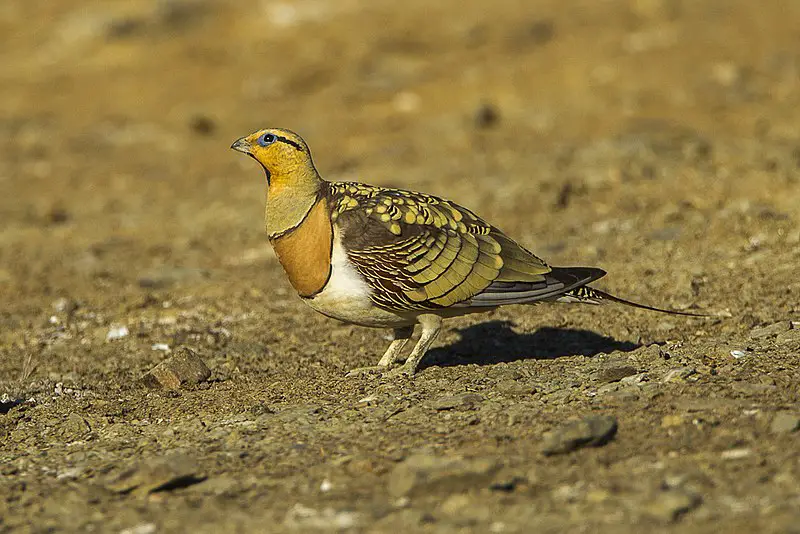
The Pin-tailed Sandgrouse is a medium-sized bird with a small, pigeon-like head and neck and sturdy body. It has long pointed wings that are white underneath, as well as a long tail and fast direct flight.
They congregate in flocks to watering holes at dawn, making loud calls of “kattar-kattar”. This social species lives on open treeless plains or similar areas where they can find food such as seeds or insects.
During breeding season the male will perform an impressive display which involves fanning out its tail feathers while displaying his bright yellow eye patch to attract females.
The male also provides water for the female by sopping up moisture from damp ground in its breast feathers before flying back to meet her at their nest site where she incubates their eggs until hatching occurs.
These birds have adapted over time to survive some harsh climates but now face threats due to habitat destruction and hunting pressure; conservation efforts must be put into place if we are going keep this incredible species alive for future generations.Scientific classification:
| Kingdom | Animalia |
| Phylum | Chordata |
| Class | Aves |
| Order | Pterocliformes |
| Family | Pteroclidae |
| Genus | Pterocles |
| Species | P. alchata |
Also Featured In: Birds That Live in Iraq, Birds that Live in the Deserts
15. Kurdish Wheatear
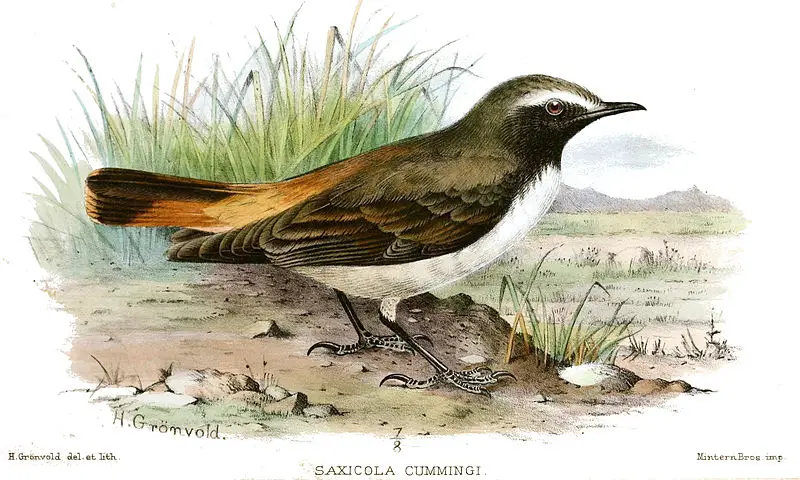
The Kurdish Wheatear is a species of bird in the Muscicapidae family. It’s also known as the Kurdistan wheatear, chestnut-rumped wheater or red-rumped wheatear.
These birds have reddish tails and rump feathers which give them their name. They are found mainly in northern Iraq and western Iran but can be seen migrating through other parts of Europe too during springtime.
The red-tailed Wheater (Oenanthe chrysopygia) was thought to be a subspecies at one time, but now it is considered a separate species altogether that may intergrade with these birds in places like Iran (“O x cummingi”).
The Kurds Wheaters usually feed on insects such as beetles, flies and grasshoppers along with berries when available for sustenance.Scientific classification:
| Kingdom | Animalia |
| Phylum | Chordata |
| Class | Aves |
| Order | Passeriformes |
| Family | Muscicapidae |
| Genus | Oenanthe |
| Species | O. xanthoprymna |
16. Laughing Dove
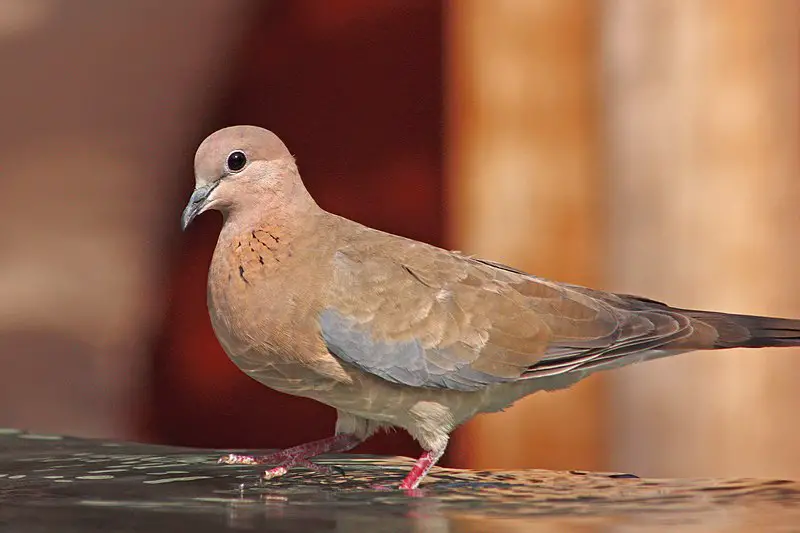
The Laughing Dove is a small and long-tailed pigeon found in dry, scrubby or semi-desert habitats. These birds are native to Africa, the Middle East, South Asia and Western Australia where they were released from Perth Zoo in 1898.
A unique feature of these doves is their call which sounds like low laughter – hence its name.
They form pairs when feeding on the ground, often near water sources such as pools or riverbanks. The diet of this bird consists mainly of seeds with some invertebrates also taking up part of it.
This species has adapted well to different environments due to its ability to find food resources easily even during times when other foods may be scarce.Scientific classification:
| Kingdom | Animalia |
| Phylum | Chordata |
| Class | Aves |
| Order | Columbiformes |
| Family | Columbidae |
| Genus | Spilopelia |
| Species | S. senegalensis |
17. Crab-Plover
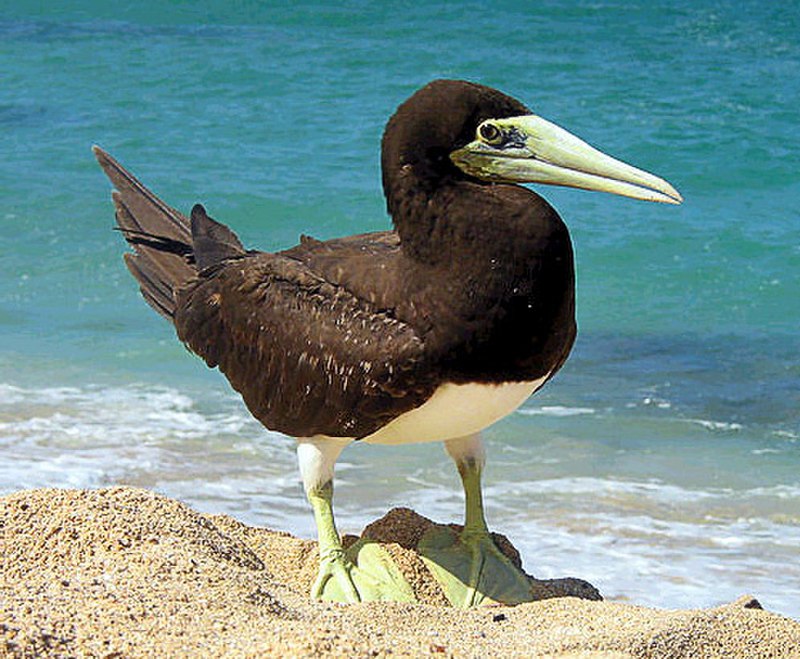
The crab-plover is an exceptional bird which belongs to its own family, Dromadidae. It appears to be closely related to the waders and other Charadriiformes such as auks, gulls and thick-knees.
This species of bird has a unique look; it is white with black markings on its head and wings. Its long bill helps them dig for food in sand or mudflats.
They can also fly up into the air when disturbed by predators or people too close for comfort.
The crab plover spends most of its life near beaches where they feed on crabs, fish eggs and small insects found there.
These birds are highly social during breeding season but solitary at other times throughout their annual cycle making them difficult creatures to spot out in the wild but well worth trying.Scientific classification:
| Kingdom | Animalia |
| Phylum | Chordata |
| Class | Aves |
| Order | Charadriiformes |
| Suborder | Lari |
| Family | Dromadidae GR Gray, 1840 |
| Genus | Dromas Paykull, 1805 |
| Species | D. ardeola |
18. Great Knot
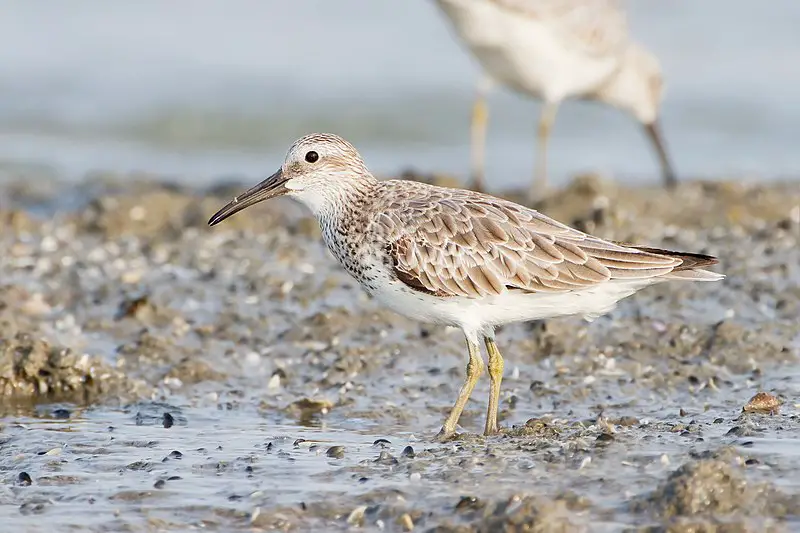
The Great knot is an impressive small wader species belonging to the Calidrid family. It has a slender bill and grey colouring, which is what inspired its genus name “Calidris” from Aristotle’s term for some waterside birds.
During breeding season it inhabits tundra in northeast Siberia where it builds nests on the ground and lays around four eggs at one time.
Its diet consists of insects, crustaceans, molluscs and worms which are found along coastal areas during migration; they may also roost together with other bird species such as Bar-tailed Godwit or Dunlin when not migrating or breeding.
The Great Knot’s population numbers have recently declined due to hunting pressure, loss of habitat through climate change and pollution-related incidents – making them vulnerable conservation concern.Scientific classification:
| Kingdom | Animalia |
| Phylum | Chordata |
| Class | Aves |
| Order | Charadriiformes |
| Family | Scolopacidae |
| Genus | Calidris |
| Species | C. tenuirostris |
Also Featured In: Birds that Live in Gold Coasts, Common Townsville Birds
19. Red-Billed Tropicbird
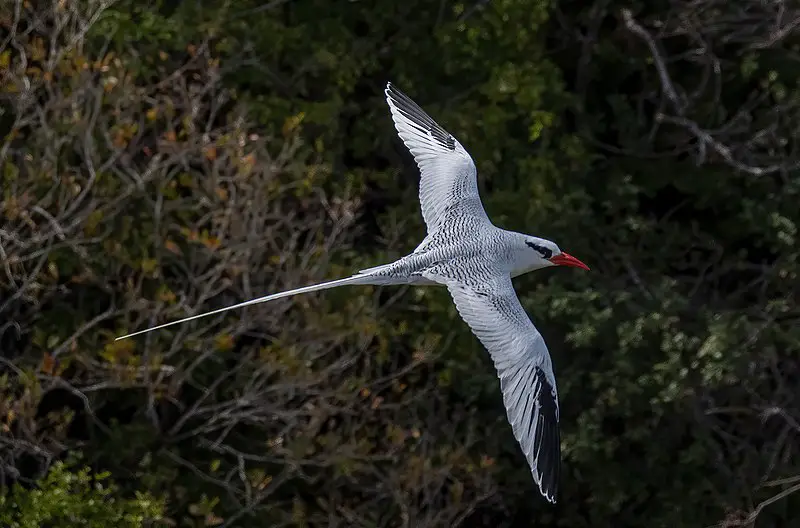
The Red-billed Tropicbird is a beautiful seabird found in tropical oceans. It has mainly white plumage, with black markings on its wings and back, along with a black mask and red bill.
These birds have distinctive long tail streamers that are twice their body length which they use to help them soar above the ocean surface while searching for food.
They primarily feed off squid, fish and crustaceans that inhabit coral reefs or deep sea areas where they can dive up to 30 meters below the water’s surface.
The Red-billed Tropicbird was once thought of as an omen of bad luck but now it serves as a reminder of how delicate our marine ecosystems are when faced with human activity such as overfishing.Scientific classification:
| Kingdom | Animalia |
| Phylum | Chordata |
| Class | Aves |
| Order | Phaethontiformes |
| Family | Phaethontidae |
| Genus | Phaethon |
| Species | P. aethereus |
20. Brown-Necked Raven
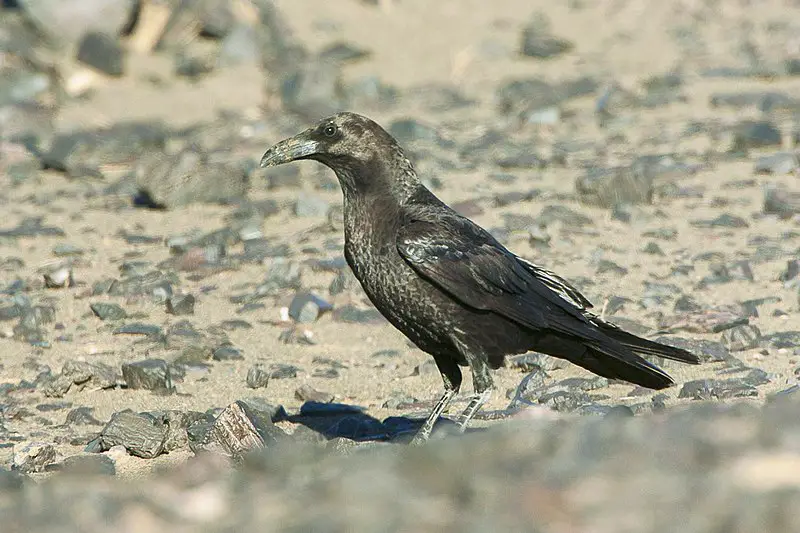
The Brown-necked Raven is a sturdy, large bird. It has an average length of 52 – 56 cm and similar proportions to the Common Raven but with a smaller bill.
Its distinct brownish black head and throat give it its name; the rest of its plumage consists of grey on the back, wings and tail feathers, as well as white underparts.
This species can be found in parts of North Africa, Asia Minor and across most areas in Iran.
They have also been known to inhabit forest edges or other open woodlands where they feed mainly on small mammals such as rodents, lizards, insects or even carrion when necessary for survival.
The Brown-necked raven is highly intelligent birds that form strong family bonds which last until death do them part.Scientific classification:
| Kingdom | Animalia |
| Phylum | Chordata |
| Class | Aves |
| Order | Passeriformes |
| Family | Corvidae |
| Genus | Corvus |
| Species | C. ruficollis |
21. Little Crake
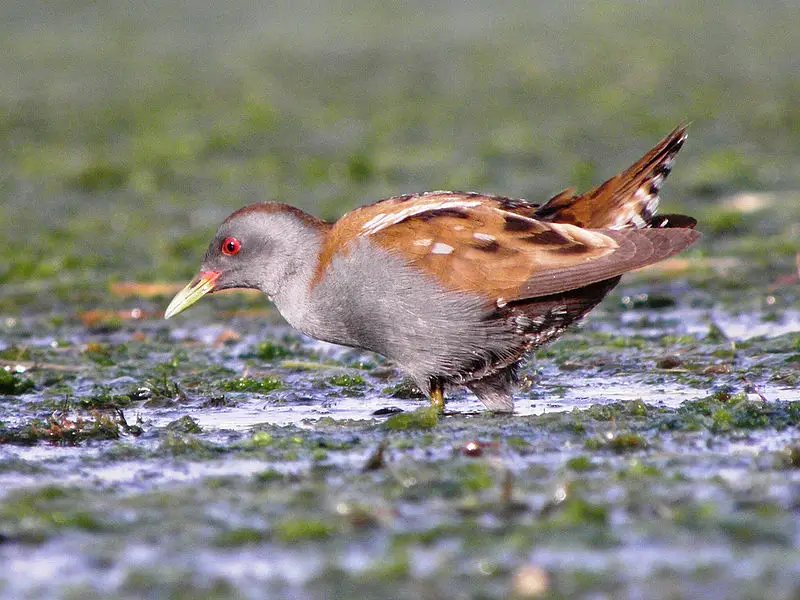
The Little Crake (Zapornia parva) is one of the smallest waterbirds in the family Rallidae. It breeds mainly in reed beds found throughout Europe and western Asia, migrating to Africa for winter months.
Measuring 17-19 cm long, these birds are slightly smaller than their close relative – the Spotted Crake – which can be identified by its lack of spots on its back.
With brown plumage, black eyes and a bill that curves downwards at tips; they also have yellow legs and feet as well as white underparts with some barring towards their underside.
They feed mainly on small invertebrates and insects while nesting near lakes or pools among dense vegetation such as sedges and bulrushes where they lay 4–7 eggs between May to July each year.Scientific classification:
| Kingdom | Animalia |
| Phylum | Chordata |
| Class | Aves |
| Order | Gruiformes |
| Family | Rallidae |
| Genus | Zapornia |
| Species | Z. parva |
22. White-Cheeked Tern
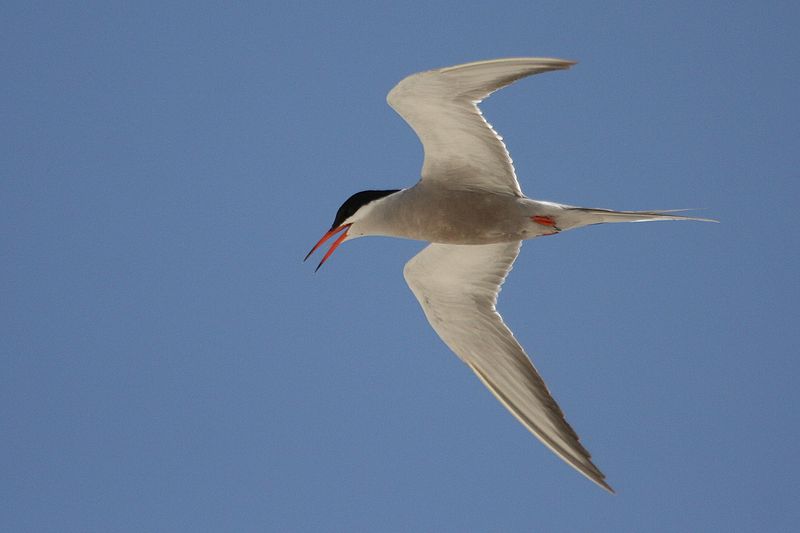
White-cheeked terns are a species of sea birds found along the coasts on the Red Sea, Horn of Africa to Kenya and Persian Gulf. They migrate during winter season with colonies ranging from 10 to 200 pairs.
These birds have white cheeks and grey upperparts which contrast against their black cap, wings and tail feathers.
In addition they possess long pointed bills making them excellent hunters for fish in both fresh or salt water habitats.
Generally solitary outside breeding times they feed using plunge dives into the water while airborne or even swimming if necessary.
During nesting time these terns become more social as parents share incubation duties before fledging young once hatched successfully.Scientific classification:
| Kingdom | Animalia |
| Phylum | Chordata |
| Class | Aves |
| Order | Charadriiformes |
| Family | Laridae |
| Genus | Sterna |
| Species | S. repressa |
23. Armenian Gull
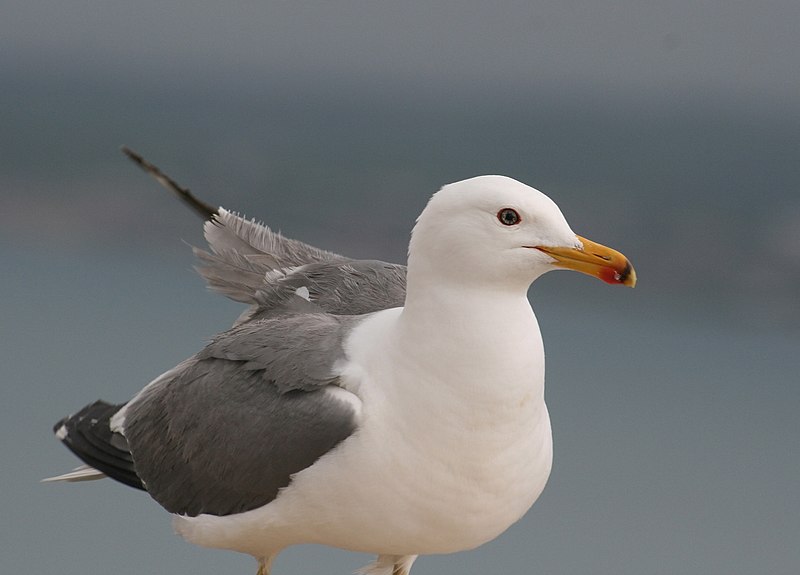
The Armenian gull is a large species of seabird found in the Caucasus and Middle East. It was previously classified as a subspecies of the European herring gull, but has now been recognised as its own separate species by BirdLife International.
On average, it measures around 48-56 cm long with an impressive wingspan up to 130cm wide. This bird typically has light grey upperparts, white underparts and black legs contrasted with yellow feet.
One interesting feature are its reddish eyes which makes them easily identifiable from other similar looking birds such as Yellow Legged Gulls or Herring Gulls.
They feed mainly on insects, fish and molluscs near coastal areas or inland wetlands during their breeding season between April – August each year when they lay 2-3 eggs in nests made out of sticks & twigs lined with grasses & feathers for insulation against extreme weather conditions.Scientific classification:
| Kingdom | Animalia |
| Phylum | Chordata |
| Class | Aves |
| Order | Charadriiformes |
| Family | Laridae |
| Genus | Larus |
| Species | L. armenicus |
Also Featured In: Armenian Birds You Should Know,
24. Isabelline Wheatear
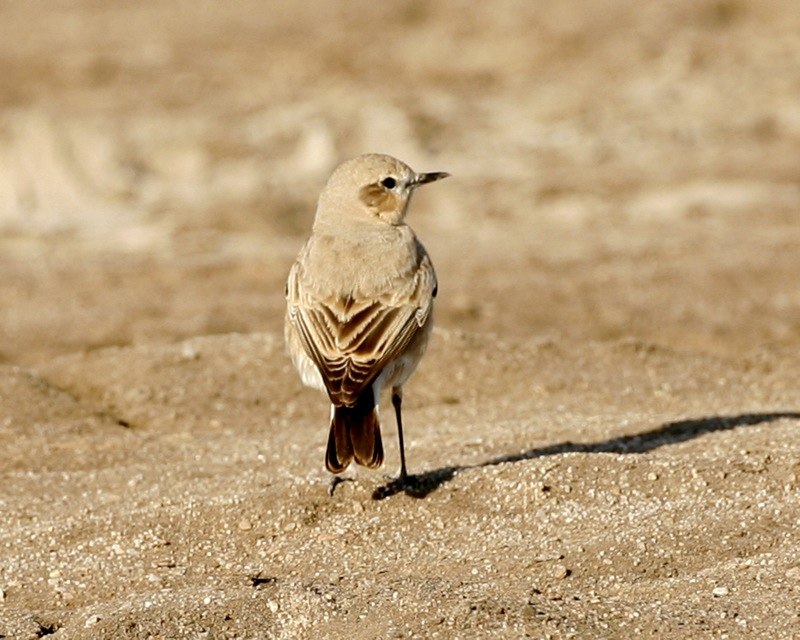
The Isabelline Wheatear is a small passerine bird belonging to the Muscicapidae family. It can be found in steppes and open countryside, breeding from southern Russia through Central Asia all the way down to northern Pakistan.
During wintertime it migrates southwards for warmer climates. Its diet mainly consists of insects which makes this species an insectivorous one.
Its usual hunting ground is on low vegetation or on bare soil where it searches for food with its agile movements and sharp bill.
The males are distinguished by their grey upperparts, light underside with buff markings around wings and tail as well as their white brow stripe that gives them their name: “Isabellina”.Scientific classification:
| Kingdom | Animalia |
| Phylum | Chordata |
| Class | Aves |
| Order | Passeriformes |
| Family | Muscicapidae |
| Genus | Oenanthe |
| Species | O. isabellina |
25. Black-Throated Thrush
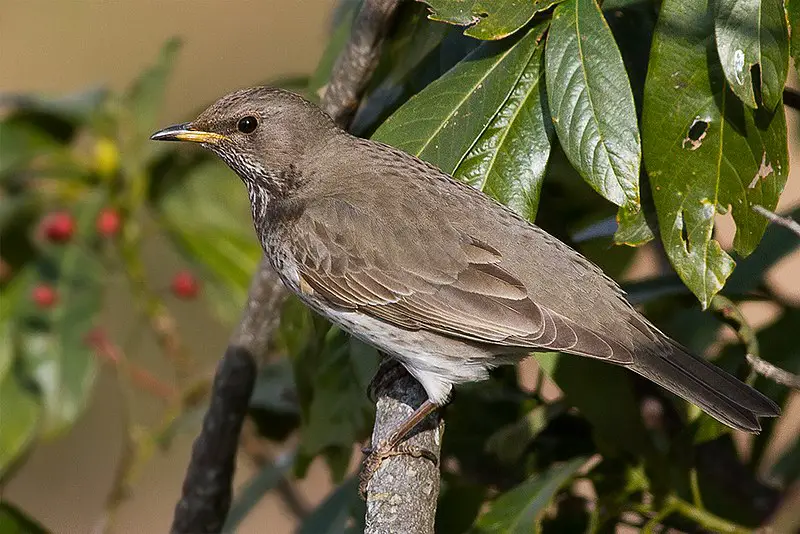
The Black-throated Thrush is a passerine bird belonging to the thrush family. It can be found in East Palearctic regions, and its range overlaps with that of the Red-throated Thrush, another member of this species.
This migratory bird has black upperparts and chest feathers, a grey head and neck, white underparts and bright yellow eyes.
During breeding season the male’s throat turns from black to brownish red whereas in females it remains dark throughout the year.
The Black-throated Thrush feeds on fruits such as berries but also eats insects for extra protein during migration journeys or when feeding young ones.
Its song is composed of beautifully fluted notes which alternate between loud bursts followed by quieter passages – a real treat for any nature lover.Scientific classification:
| Kingdom | Animalia |
| Phylum | Chordata |
| Class | Aves |
| Order | Passeriformes |
| Family | Turdidae |
| Genus | Turdus |
| Species | T. atrogularis |
26. Desert Wheatear
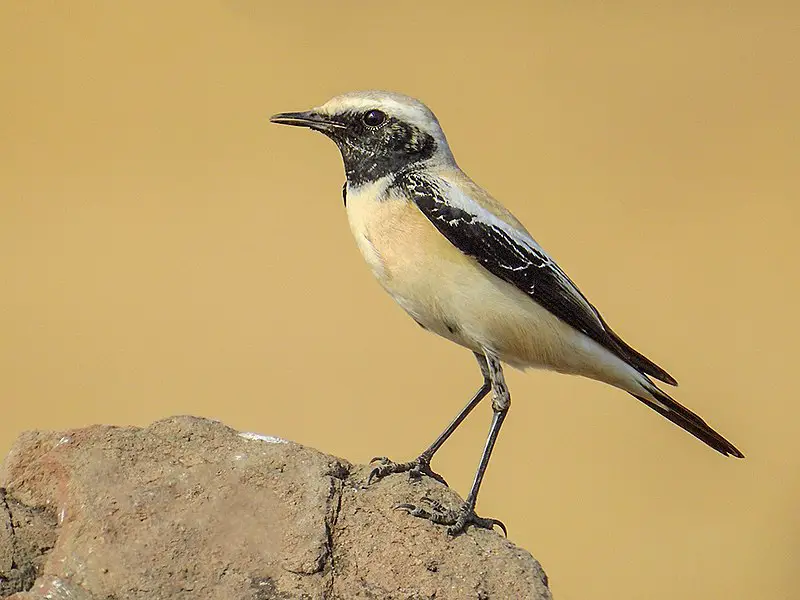
The Desert Wheatear is a small passerine bird that typically inhabits desert and semi-desert areas. It measures 14.5 to 15 cm in length, making it slightly larger than most thrushes but smaller than many Old World flycatchers.
The upper parts of this species are greyish-brown with black streaking, while the underparts are whitish or buffy white with some cinnamon on its sides and flanks.
Its tail has two prominent white bars at the tip which contrast starkly against its otherwise dark plumage.
During breeding season males will often display their conspicuous orange throat patch as part of courtship behaviour towards females of the species.
However, outside of mating season both sexes share identical plumages without any discernible differences between them apart from size variations common among all birds.
This insectivorous species mostly feeds on flying insects such as moths, beetles and bees that they catch midair during short sallies out into open spaces near coverts where they can hide if threatened by predators like other birds or mammals roaming their habitat range throughout Eurasia including rare vagrants to western Europe.Scientific classification:
| Kingdom | Animalia |
| Phylum | Chordata |
| Class | Aves |
| Order | Passeriformes |
| Family | Muscicapidae |
| Genus | Oenanthe |
| Species | O. deserti |
27. Pied Wheatear
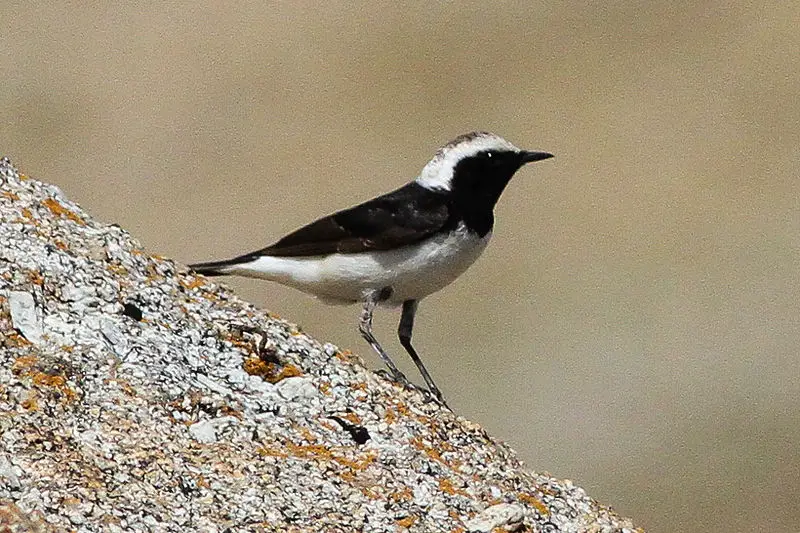
The Pied Wheatear is a small migratory bird found in Central Asia and parts of Europe, the Middle East, India and China.
It is an insectivore with its diet consisting mainly of insects such as flies, beetles and moths.
Its plumage consists mostly of black feathers on its wings and tail along white-grayish spots which gives it a distinct ‘pied’ effect that makes it quite easy to spot among other birds.
During migration season they tend to fly high up in the sky forming large flocks which can be seen from great distances away.
As far as conservation status goes this species isn’t considered threatened but due to habitat destruction their numbers are declining gradually over time making them vulnerable for potential future extinctions if not properly taken care off soon enough.Scientific classification:
| Kingdom | Animalia |
| Phylum | Chordata |
| Class | Aves |
| Order | Passeriformes |
| Family | Muscicapidae |
| Genus | Oenanthe |
| Species | O. pleschanka |